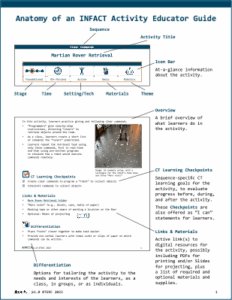Design by, with, and for Neurodivergent Learners: Part 8 — Anatomy of Activities
By Teon Edwards
As part of INFACT—Including Neurodiversity in Foundational and Applied Computational Thinking (DOE; EIR-U411C190179)—we created a comprehensive and inclusive set of materials for computational thinking in grades 3–8. We carefully crafted the materials to make them as accessible as possible for learners and the educators using them.

Each INFACT activity had the same overall structure, with consistent headers, icons, color coding, and more. Educators could easily look through the materials to:
- Decide if an activity was appropriate to their content, classes, and students… and thus something they wanted to teach;
- Gather materials and otherwise prepare, including differentiating the activity to best meet the strengths and needs of individual students; and then
- Actually lead the activity, accessing the information they need in the moment while teaching and guiding students.
The student materials, too, were carefully and consistently structured. And whenever appropriate, scaffolds were used across the educator and student materials. For example, the CT Learning Checkpoints were included on student activity sheets as “I can…” statements (e.g., “I can interpret commands to collect objects.”), so students knew the intended learning outcomes of what they were doing, and the same checkbox icon was used to make them easy to spot within and across activities.
What makes for a good activity? What makes an activity guide well designed? And what makes an activity and activity materials inclusive and accessible? INFACT attempted to tackle each of these questions, with the “anatomy of an INFACT activity” being just one result.
As part of INFACT—Including Neurodiversity in Foundational and Applied Computational Thinking (DOE; EIR-U411C190179)—we created a comprehensive and inclusive set of materials for computational thinking in grades 3–8. We carefully crafted the materials to make them as accessible as possible for learners and the educators using them.

Each INFACT activity had the same overall structure, with consistent headers, icons, color coding, and more. Educators could easily look through the materials to:
- Decide if an activity was appropriate to their content, classes, and students… and thus something they wanted to teach;
- Gather materials and otherwise prepare, including differentiating the activity to best meet the strengths and needs of individual students; and then
- Actually lead the activity, accessing the information they need in the moment while teaching and guiding students.
The student materials, too, were carefully and consistently structured. And whenever appropriate, scaffolds were used across the educator and student materials. For example, the CT Learning Checkpoints were included on student activity sheets as “I can…” statements (e.g., “I can interpret commands to collect objects.”), so students knew the intended learning outcomes of what they were doing, and the same checkbox icon was used to make them easy to spot within and across activities.
What makes for a good activity? What makes an activity guide well designed? And what makes an activity and activity materials inclusive and accessible? INFACT attempted to tackle each of these questions, with the “anatomy of an INFACT activity” being just one result.

10/6/2025
AuthorTeon Edwards is the director and a co-founder of EdGE at TERC. Her current work focuses on the use of virtual reality and other technologies to design and develop inclusive STEM learning experiences, with a particular focus on neurodiversity and sensory, attention, and social differences.
SummaryTeon Edwards, PI of Broadening Participation in Informal STEM Learning for Autistic Learners and Others through Virtual Reality, wraps up her blog series and the “anatomy of an INFACT activity.”
More Posts in this Series- Part 1 — Introduction
- Part 2 — Computational Thinking Posters
- Part 3 — Zoombinis Allergic Cliffs Flashlight Scaffold
- Part 4 — Zoombinis Allergic Cliffs Expression Scaffold
- Part 5 — Brightness Controls
- Part 6 — Red Alert
- Part 7 — Word Cards
Share This Page:
